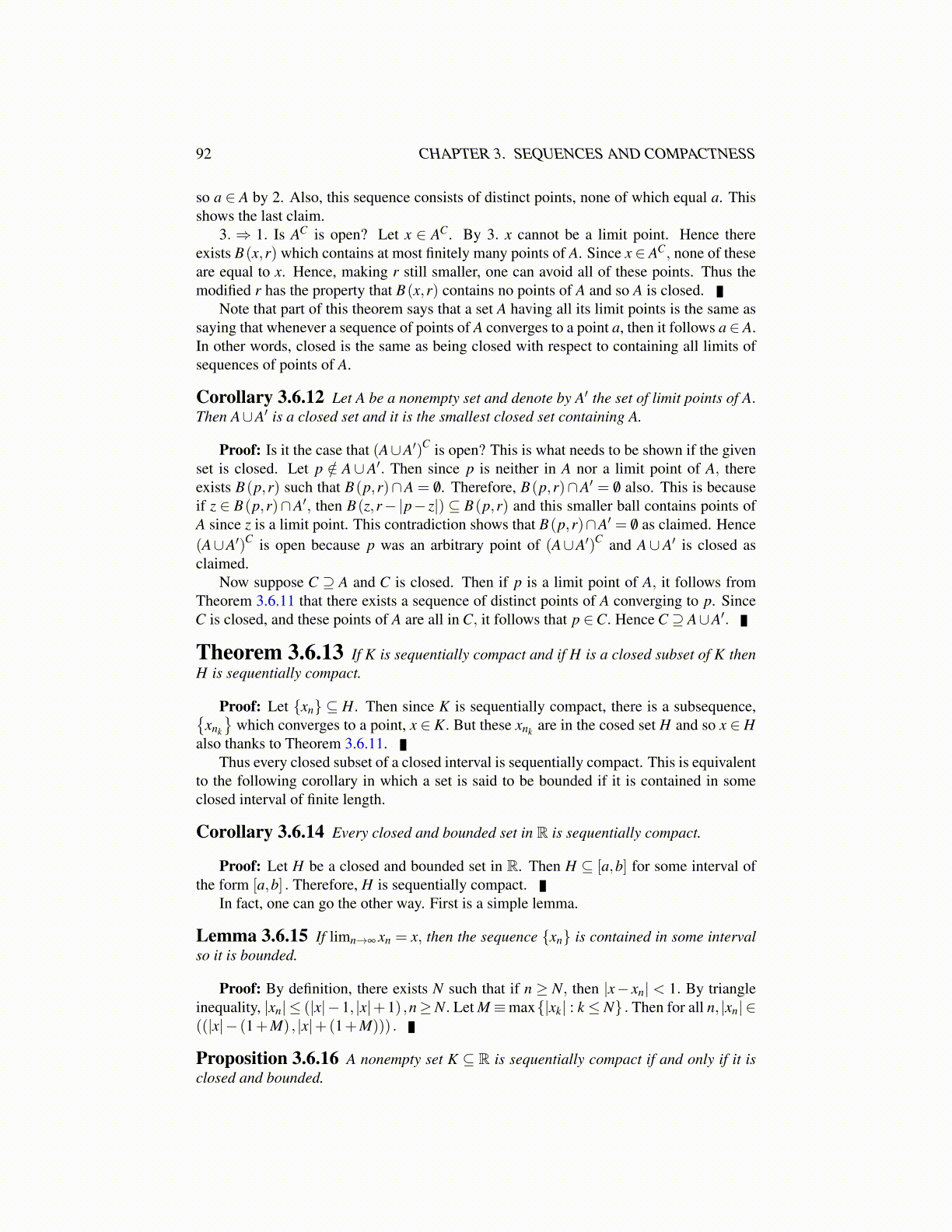
92 CHAPTER 3. SEQUENCES AND COMPACTNESS
so a ∈ A by 2. Also, this sequence consists of distinct points, none of which equal a. Thisshows the last claim.
3. ⇒ 1. Is AC is open? Let x ∈ AC. By 3. x cannot be a limit point. Hence thereexists B(x,r) which contains at most finitely many points of A. Since x ∈ AC, none of theseare equal to x. Hence, making r still smaller, one can avoid all of these points. Thus themodified r has the property that B(x,r) contains no points of A and so A is closed.
Note that part of this theorem says that a set A having all its limit points is the same assaying that whenever a sequence of points of A converges to a point a, then it follows a ∈ A.In other words, closed is the same as being closed with respect to containing all limits ofsequences of points of A.
Corollary 3.6.12 Let A be a nonempty set and denote by A′ the set of limit points of A.Then A∪A′ is a closed set and it is the smallest closed set containing A.
Proof: Is it the case that (A∪A′)C is open? This is what needs to be shown if the givenset is closed. Let p /∈ A∪A′. Then since p is neither in A nor a limit point of A, thereexists B(p,r) such that B(p,r)∩A = /0. Therefore, B(p,r)∩A′ = /0 also. This is becauseif z ∈ B(p,r)∩A′, then B(z,r−|p− z|) ⊆ B(p,r) and this smaller ball contains points ofA since z is a limit point. This contradiction shows that B(p,r)∩A′ = /0 as claimed. Hence(A∪A′)C is open because p was an arbitrary point of (A∪A′)C and A∪A′ is closed asclaimed.
Now suppose C ⊇ A and C is closed. Then if p is a limit point of A, it follows fromTheorem 3.6.11 that there exists a sequence of distinct points of A converging to p. SinceC is closed, and these points of A are all in C, it follows that p ∈C. Hence C ⊇ A∪A′.
Theorem 3.6.13 If K is sequentially compact and if H is a closed subset of K thenH is sequentially compact.
Proof: Let {xn} ⊆ H. Then since K is sequentially compact, there is a subsequence,{xnk
}which converges to a point, x ∈ K. But these xnk are in the cosed set H and so x ∈ H
also thanks to Theorem 3.6.11.Thus every closed subset of a closed interval is sequentially compact. This is equivalent
to the following corollary in which a set is said to be bounded if it is contained in someclosed interval of finite length.
Corollary 3.6.14 Every closed and bounded set in R is sequentially compact.
Proof: Let H be a closed and bounded set in R. Then H ⊆ [a,b] for some interval ofthe form [a,b] . Therefore, H is sequentially compact.
In fact, one can go the other way. First is a simple lemma.
Lemma 3.6.15 If limn→∞ xn = x, then the sequence {xn} is contained in some intervalso it is bounded.
Proof: By definition, there exists N such that if n ≥ N, then |x− xn| < 1. By triangleinequality, |xn| ≤ (|x|−1, |x|+1) ,n≥N. Let M ≡max{|xk| : k ≤ N} . Then for all n, |xn| ∈((|x|− (1+M) , |x|+(1+M))) .
Proposition 3.6.16 A nonempty set K ⊆ R is sequentially compact if and only if it isclosed and bounded.